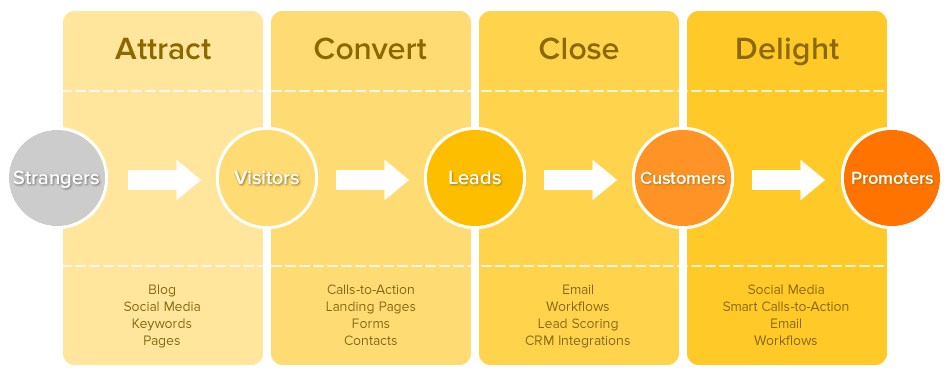Inbound Marketing – No Gimmicks; Just Results

You may be wondering what inbound marketing is, or how it can help your business. It’s important to understand that it’s not just a marketing method – it’s an entirely new way of thinking.
Inbound marketing is the business of helping people find what they need, because let’s face it: no one likes being sold to. Buyers have all the power to tune out phony advertisements and impersonal ads.
There’s a better way to engage with your visitors, all while being personal and resonating with their needs. That way is inbound marketing, and it’s been proven to work.

The approach in a nutshell is about helping strangers find what they need on your website, and then turning them from visitors into leads, customers, and finally, happy promoters of your brand.
This is accomplished in 4 easy steps: attract, convert, close, and delight.

Step 1
Attract
The “Attract” step is what brings strangers to you website. It’s the foundation of inbound, and probably one of the most pivotal steps that many get wrong or don’t implement effectively. Think of where you (and everybody else) goes to find out information – a search engine. From these results, you’re seeking to show up and entice them to go to your site. This is accomplished using quality content focused around your buyer persona’s pain points. Think of blogs and any other content that’s shared.
Step 2
Convert
After you’ve gotten a stranger onto your website, it’s time to help them! Perhaps there’s a checklist or eBook on how to jumpstart content marketing that they’re interested in reading more about. By directing them to a call-to-action (CTA) and form, you can accomplish the second step of the methodology, which is converting them on a piece of content. After they fill out a form, they become a contact in your database, and someone you’ll be able to market to again! No billboards or buying lists required.
Step 3
Close
By this step in the methodology, you have leads. The closing step is all about nurturing these leads with quality content (such as emails and workflows) so they can continue down the buyer’s journey in order to make a decision on their pain point. This is very much so the “easier-said-than-done” step. Closing takes time, and an integrated strategy between your marketing and sales teams. What you’ve given leads in marketing in terms of helpfulness? They’ll expect all that and more in sales. Make sure you’re prepared to help, not sell, and you’ll be well on your way to closing more deals.
Step 4
Delight
Your customers are extremely important, and shouldn’t be overlooked! Delighting your existing customer base is key in maintaining customer satisfaction and continuing to exceed their expectations. At the end of the day, it’s all about service and how you can benefit them over the competition. This is especially true if your service is recurring/repeatable, and not just one-time. Although this is easy to overlook, set time aside to hone in on improving your customer experience, and this will ensure you have high retention and satisfaction.





